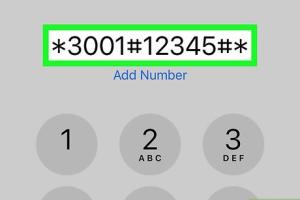Mastering USSD Codes: A Comprehensive Guide for Beginners

-
Quick Links:
- What is USSD?
- How USSD Works
- Why Use USSD Codes?
- How to Run USSD Codes
- Common USSD Codes
- Case Studies on USSD Usage
- Troubleshooting USSD Issues
- The Future of USSD Technology
- FAQs
What is USSD?
Unstructured Supplementary Service Data (USSD) is a protocol used by GSM cellular telephones to communicate with the service provider's computers. Unlike SMS, which can be sent and stored, USSD is a real-time communication tool that allows users to interact with mobile applications without the need for an internet connection. This technology is commonly used for services like mobile banking, prepaid mobile credit, and various telecom services.
How USSD Works
USSD codes start with an asterisk (*) and end with a hash (#). When a user dials a USSD code, it establishes a session with the service provider's server and sends a request for service. The server processes the request and sends back a response, which is displayed on the user's screen in real-time. This process occurs over a voice channel, making it quicker and more efficient compared to SMS.
Why Use USSD Codes?
USSD codes offer several advantages:
- Real-time interaction: Immediate feedback and responses.
- No internet required: Works without a data connection.
- Quick access: Fast service activation and information retrieval.
- Widespread availability: Accessible on most mobile phones.
How to Run USSD Codes
Running a USSD code is straightforward. Here are the steps to follow:
- Open your phone's dialer.
- Type the USSD code you want to run, making sure it starts with an asterisk (*) and ends with a hash (#).
- Press the call button.
- Wait for the response from the service provider, which will display on your screen.
- Follow any prompts or instructions provided in the response.
For example, if you want to check your mobile balance, you might dial *123# and follow the prompts given.
Common USSD Codes
Here are some commonly used USSD codes by popular service providers:
| Service Provider | USSD Code | Function |
|---|---|---|
| AT&T | *225# | Check balance |
| Verizon | *611 | Customer service |
| T-Mobile | *123# | Check data balance |
| MetroPCS | *99# | Check account balance |
Case Studies on USSD Usage
To understand the impact of USSD technology, let’s look at a few case studies:
Case Study 1: Mobile Banking in Africa
In many African countries, USSD has become the backbone of mobile banking. For instance, M-Pesa in Kenya allows users to send and receive money, pay bills, and buy airtime through USSD codes. This service has significantly increased financial inclusion in regions where traditional banking is limited.
Case Study 2: Telecom Services in India
Indian telecom companies use USSD codes to provide services such as checking balance, recharging plans, and accessing customer support. This has helped millions of users, especially in rural areas, to access services without needing a smartphone or internet connection.
Troubleshooting USSD Issues
Sometimes, users may face issues when trying to run USSD codes. Here are common problems and solutions:
- Code not working: Ensure you are entering the correct code and that your phone has a signal.
- No response: Try dialing the code again after a few minutes. Network congestion might cause delays.
- Session expired: If a session times out, simply redial the code to start a new session.
The Future of USSD Technology
As technology evolves, the relevance of USSD may be challenged by apps and mobile internet. However, due to its simplicity and accessibility, USSD is likely to remain a vital tool for communication and service access, especially in areas with limited internet connectivity.
FAQs
1. What devices support USSD codes?
Most GSM mobile phones support USSD codes, making it accessible to both smartphones and basic mobile devices.
2. Are USSD codes secure?
USSD codes themselves are not encrypted, so sensitive operations should be performed carefully, especially with financial transactions.
3. Can I use USSD codes internationally?
USSD codes are often specific to the network provider and may not work if you are roaming in another country unless the service provider supports it.
4. How can I find USSD codes for my provider?
Most telecom providers list their USSD codes on their websites or customer service portals. You can also contact customer support for assistance.
5. What should I do if a USSD code gives an error?
Check that you entered the code correctly, ensure your device has network coverage, and try again later. If the problem persists, contact your service provider.
6. Can USSD codes be used for customer service?
Yes, many companies provide customer service via USSD codes, allowing users to access support without needing to call.
7. Are there limitations to USSD codes?
USSD sessions are generally limited to a certain time and number of interactions, and they may not support very complex transactions.
8. How do USSD codes differ from SMS?
USSD is real-time and interactive, whereas SMS is a store-and-forward service that does not allow for two-way communication in real time.
9. Can I create my own USSD code?
Creating a USSD code typically requires working with a mobile operator or a service provider that has the infrastructure to support it.
10. What industries benefit from USSD technology?
Banking, telecommunications, healthcare, and e-commerce are some of the industries that benefit from USSD technology due to its accessibility and efficiency.